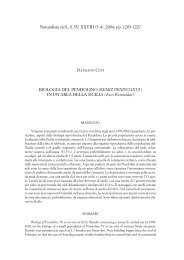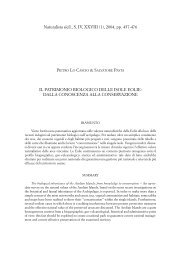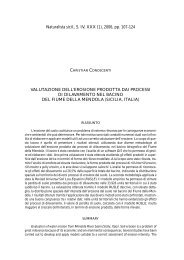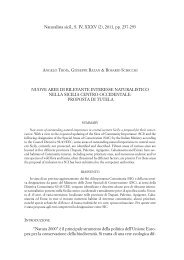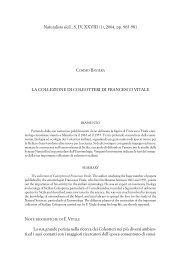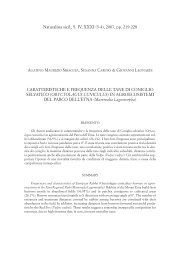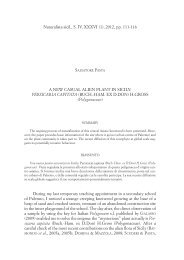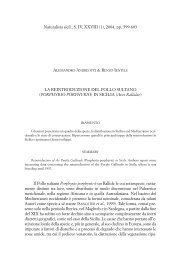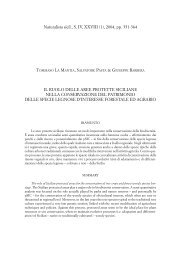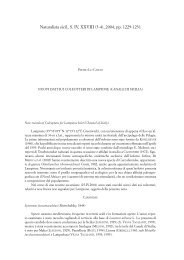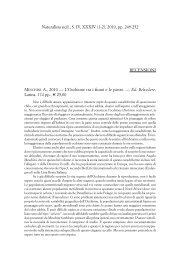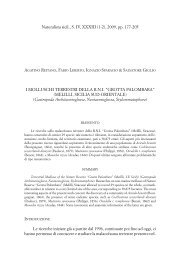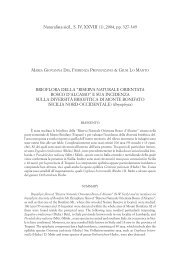Un caso di necrofagia nel Gheppio (Falco tinnunculus) - sssn.it
Un caso di necrofagia nel Gheppio (Falco tinnunculus) - sssn.it
Un caso di necrofagia nel Gheppio (Falco tinnunculus) - sssn.it
Create successful ePaper yourself
Turn your PDF publications into a flip-book with our unique Google optimized e-Paper software.
Naturalista sicil., S. IV, XXIX (3-4), 2005, pp. 183-186BREVI NOTEAGATINO MAURIZIO SIRACUSA & TONI PUMAUN CASO DI NECROFAGIA NEL GHEPPIO (FALCO TINNUNCULUS)A case of necrophagy in Kestrel (<strong>Falco</strong> <strong>tinnunculus</strong>).Il <strong>Gheppio</strong> (<strong>Falco</strong> <strong>tinnunculus</strong>) è un piccolo <strong>Falco</strong>niforme a <strong>di</strong>stribuzione Paleartico–paleotropicalerelativamente <strong>di</strong>ffuso e comune in tutta la Sicilia; preda preferenzialmente micromammiferi,Uccelli, Rettili e Artropo<strong>di</strong> (CRAMP & SIMMONS, 1980). In Sicilia cattura soprattutto Insetti eRettili mentre la categoria più importante in termini <strong>di</strong> biomassa è rappresentata dai micromammiferi(MASSA, 1981; RIZZO et al., 1993). Il 30 <strong>di</strong>cembre 2002, in local<strong>it</strong>à S. Stefano della Quisquina(Agrigento), è stato osservato un in<strong>di</strong>viduo mentre si nutriva <strong>di</strong> un gatto domestico (Felis silvestriscatus) morto ai bor<strong>di</strong> <strong>di</strong> una strada (Fig. 1). La <strong>necrofagia</strong> non è frequente <strong>nel</strong>le specie del genere<strong>Falco</strong>, che <strong>di</strong> norma si alimentano <strong>di</strong> prede vive (DEL HOYO et al., 1994); più in particolare, <strong>nel</strong> <strong>caso</strong>del <strong>Gheppio</strong>, questo comportamento sembrerebbe non essere noto (CRAMP & SIMMONS, 1980; DELHOYO et al., 1994).Sempre in Sicilia, relativamente ad un’altra specie <strong>di</strong> <strong>Falco</strong>nide, il Lanario (<strong>Falco</strong> biarmicus),sono stati segnalati altri due casi <strong>di</strong> <strong>necrofagia</strong>, il primo anche su gatto domestico (FALCONE, 1987),il secondo su Martora (Martes martes) (SIRACUSA et al., 1988).Fig. 1 — <strong>Gheppio</strong>mentre si alimentasu <strong>di</strong> un gattomorto (Foto T.Puma).
184 Brevi noteBIBLIOGRAFIACRAMP S. & SIMMONS K.E.L, 1980 — The Birds of the Western Paleartic. II. — Oxford <strong>Un</strong>iv. Press.FALCONE., 1987 — <strong>Un</strong> <strong>caso</strong> <strong>di</strong> <strong>necrofagia</strong> <strong>di</strong> Lanario <strong>Falco</strong> biarmicus. — Naturalista sicil., 10 (1986):105.DEL HOYO J., ELLIOT A., & SARGATAL J. (eds), 1994 — Handbook of the Birds of the World. Vol. 2New World Vultures to Guineafowl. — Lynx E<strong>di</strong>cions, Barcelona. Pp. 638.MASSA B., 1981 — Le régime alimentaire de quatorze espèces de Rapaces en Sicilie. In : Rapacesmé<strong>di</strong>terranéens — Ann. du CROP, 1 : 119-129.RIZZO M.C., MIGLIORE L. & MASSA B., 1993 — Insects, small mammals and bree<strong>di</strong>ng performanceof farmland populations of the Common Kestrel (<strong>Falco</strong> <strong>tinnunculus</strong>) in Sicily. Pp 11-18 in: Nicholls M.K. & Clarke R. (eds.), Biology and Conservation of small falcons.— Hawk and Owl Trust, London.SIRACUSA M., LO VALVO F., MASSA B. & CIACCIO A., 1988 — Nicchia trofica <strong>di</strong> Lanario (<strong>Falco</strong> biarmicus)e Pellegrino (<strong>Falco</strong> peregrinus) in una regione <strong>di</strong> simpatria — Atti IV Conv. <strong>it</strong>al.Orn., Naturalista sicil., 12 (suppl): 123-128.In<strong>di</strong>rizzo degli autori. — A. M. SIRACUSA & T. PUMA, Dipartimento <strong>di</strong> Biologia Animale “MarcelloLa Greca”, Via Androne 81 – 95100 Catania (I).
Brevi note185VITO DAVIDE CASTELLIPRIMA SEGNALAZIONE DI CYPRAEA (EROSARIA) TURDUS(LAMARCK 1810) NEL CANALE DI SICILIAFirst report of Cypraea (Erosaria) turdus (Lamarck 1810) in the Sicilian Chan<strong>nel</strong>Nel mese d’ottobre del 2005, il Sig. Salvatore Marrone, <strong>di</strong>rettore macchine del motopeschereccio“Monastir”, mi ha recap<strong>it</strong>ato quattro esemplari <strong>di</strong> Cypraea (Erosaria) turdus (Lamarck 1810),appartenenti alla forma “pardalina”, raccolte vive al lim<strong>it</strong>e della zona chiamata in gergo marinaresco“Mammellone”, 45 miglia a sud <strong>di</strong> Lampedusa (Isole Pelagie), a circa 45 metri <strong>di</strong> profon<strong>di</strong>tà. Si trattadel primo r<strong>it</strong>rovamento <strong>di</strong> questa specie tropicale <strong>nel</strong> Canale <strong>di</strong> Sicilia e <strong>di</strong> una delle poche segnalazionidella stessa <strong>nel</strong> Me<strong>di</strong>terraneo; infatti, la Cypraea turdus ha una <strong>di</strong>stribuzione che abbraccia ilMar Rosso, il Nord-Ovest dell’Oceano In<strong>di</strong>ano ed il Golfo Persico (BURGESS, 1985). MOAZZO (1939)l’aveva trovata vivente <strong>nel</strong> canale <strong>di</strong> Suez. La presenza della specie <strong>nel</strong> Me<strong>di</strong>terraneo è stata segnalataper la prima volta <strong>nel</strong> 1980 a Dor (Israele) (BARASH & DANIN, 1986) ed in segu<strong>it</strong>o GIANNUZZIabImmagine dorsale e ventrale <strong>di</strong>uno dei quattro esemplari <strong>di</strong>Cypraea (Erosaria) turdus(Lamarck 1810) raccolti <strong>nel</strong>leacque a sud <strong>di</strong> Lampedusa.
186 Brevi noteSAVELLI et al. (1997) hanno illustrato un esemplare <strong>di</strong> Port Said (Eg<strong>it</strong>to). Più recentemente, WIMART-ROUSSEAU & WIMART-ROUSSEAU (2003) hanno rinvenuto alcuni esemplari viventi <strong>di</strong> questa Cypraeain alcune local<strong>it</strong>à dell’isola <strong>di</strong> Djerba (Tunisia).Ringraziamenti — Ringrazio Salvatore Marrone, che mi ha donato i quattro esemplari (conservati<strong>nel</strong>la mia collezione), V<strong>it</strong>torio Emanuele Orlando, Riccardo Giannuzzi Savelli e PhilippeGuillerm, che mi hanno forn<strong>it</strong>o le utili informazioni che hanno permesso la stesura <strong>di</strong> questa nota.BIBLIOGRAFIABARASH A. & DANIN Z., 1986 — Further ad<strong>di</strong>tions to the knowledge of Indo-Pacific Mollusca in theMe<strong>di</strong>terranean Sea. — Spixiana, 9 (2): 117-141.BURGESS C. M., 1985 — A Guide to WorldWide Cowries. Gordon Verhoef Seacomber Publ., 289:211.GIANNUZZI SAVELLI R., PUSATERI F, PALMERI A. & EBREO C., 1997 — Atlante delle conchiglie marinedel Me<strong>di</strong>terraneo, Vol 2. La Conchiglia, Roma, 258 pp.MOAZZO P.G, 1939 — Mollusques testacès marins du Canal de Suez. — Memoires de l’Inst<strong>it</strong>utd’Egypte, 38: 1-283, pl. 1-14.WIMART-ROUSSEAU D. & WIMART-ROUSSEAU J., 2003 — Erosaria turdus vivante à Djerba! —Xenophora, 105: 7-8.In<strong>di</strong>rizzo dell’Autore — V. D. CASTELLI, Via Stresa, 101, Borgata Costiera - Jardìn Esperides -91026 Mazara del Vallo (TP) (I); e-mail: bejequenoble@virgilio.<strong>it</strong>



